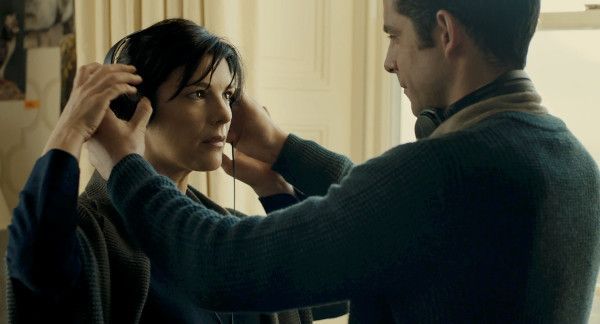In a lot of classic Hollywood monster movies, from King Kong to Dracula to The Mummy to The Creature From the Black Lagoon, there is always the implied threat that these monsters, as horrific as they are may have the power to seduce and steal our weak-willed women and that it is the role of our straight-laced men to drive of the beast and restore the social order. It is into that context that Guillermo Del Toro sledgehammers his way through the subtext with his latest monster movie The Shape of Water, with the end results being another meticulously realized and magically spun tale that evokes so much of film’s past but is very much its own thing.
Elisa Esposito (Sally Hawkins) is a lonely mute janitor in 1960s Baltimore whose inability to vocalize leaves her with few companions (including the predictably awesome Richard Jenkins and Octavia Spencer) and a routine life that exacerbates her isolation. Into her world steps a magical Amphibian man (played magnificently by Del Toro muse Toby Jones) from the Amazon who has been brought into the ocean laboratory where she cleans to be subjected to horrific scientific experimentation. Slowly Elisa finds herself drawn to this abused creature first out of pure curiosity and then out of an ever growing affection for it/him leading this timid woman to go out of her way to help it/him. Unfortunately standing in the way of their relationship is a cavalcade of obstacles, from the cruel and unfeeling federal agent Richard Strickland (Michael Shannon) who cannot see the amphibian as anything but a foe to be vanquished to a Russian plot to steal the creature for its own purposes or destroy it if necessary.
 © 2017 Twentieth Century Fox Film Corporation
© 2017 Twentieth Century Fox Film Corporation
If there was anything resembling fairness in the acting world, we would not have to once again be talking about the criminally under-appreciated talent of Sally Hawkins because her name would universally revered. Hawkins, as the moral and narrative centre of this film, has to carry the film without the use of the spoken word but does so effortlessly. She carries her role as Elisa with the perfect mix of effervescence and steely determination, her eyes continually bright and her face so naturally expressive that at moments throughout the film I forgot that Elisa was supposed to be mute. Without the strength of her performance this twisty movie could fall apart but thankfully thanks to her the movie soars.
As with all Del Toro movies, this fantastical plot is helped by the meticulous detail he puts into the design of his world so that it looks both like a perfect recreation of our imagined past and yet so full of whimsical details that it is also a picture-book fairy tale as well. It is a dreamlike movie with many unexpected twists and turns that fully immerses you in its retro atmosphere. Del Toro bathes the movie in so many references to film history, from the marquee theatre that Elisa finds herself living above all the way down to a surreal musical dance routine Elisa engages in. Yet behind this picture of the past lies a darker tinge that Del Toro uses to frequently undermine our nostalgia. Whether it is in the manufactured authenticity of a pie shop, the way minorities are pushed to the side, or literal secrets hidden under floorboards, Del Toro paints a portrait of repression hiding beneath its veneer of civil perfection.
 © 2017 Twentieth Century Fox Film Corporation
© 2017 Twentieth Century Fox Film Corporation
Tearing up that veneer is the presence of the Amphibian man whose presence brings the deep dark secrets of the characters to the surface. The Amphibian man most obviously conjures up images of The Creature from the Black Lagoon but is also Del Toro’s best creation, as pitiful as he is menacing, repulsively monstrous yet magnetically attractive. The scientists and feds treat him as an “asset” to be controlled, quantified, and exploited for their own purpose, and yet as any purveyor of fairy tales might surmise those attempts will be futile causing the moral rot of those involved.
As you might guess, the movie is not very subtle and in fact frequently sledgehammers its message home to the audience. The villains in this movie are diabolical with little doubt as to their virtue. It is quite a feat that Michael Shannon’s Strickland is the darkest and most terrifying character Del Toro has put on screen especially for anyone who has witnessed the Capitan in Pan’s Labyrinth. Meanwhile Elisa and her allies are clearly on the side of angels and paragons of virtue (or at least a sort of virtue). Not only does the movie look like a fairy tale, it has the dualistic morality of one. This is par for course for Del Toro who frequently embraces the operatic spectacle of filmmaking and requires you to fall under his movies’ spell for them to work. But if you allow yourself to do that with The Shape of Water, then the film is magic.
In many ways The Shape of Water is an old fashioned fairy tale, told in an old fashioned way. The major beats of this story are going to feel worn and familiar. But it is in the meticulously handcrafted details of Guillermo Del Toro that this film surprises, shocks, subverts, and charms. And in Sally Hawkins, the movie has a charismatic and entrancing performance that lifts the movie into something truly astonishing.
Rating: 9/10

SaveSaveSaveSaveSaveSaveSaveSaveSaveSave
Share this:




